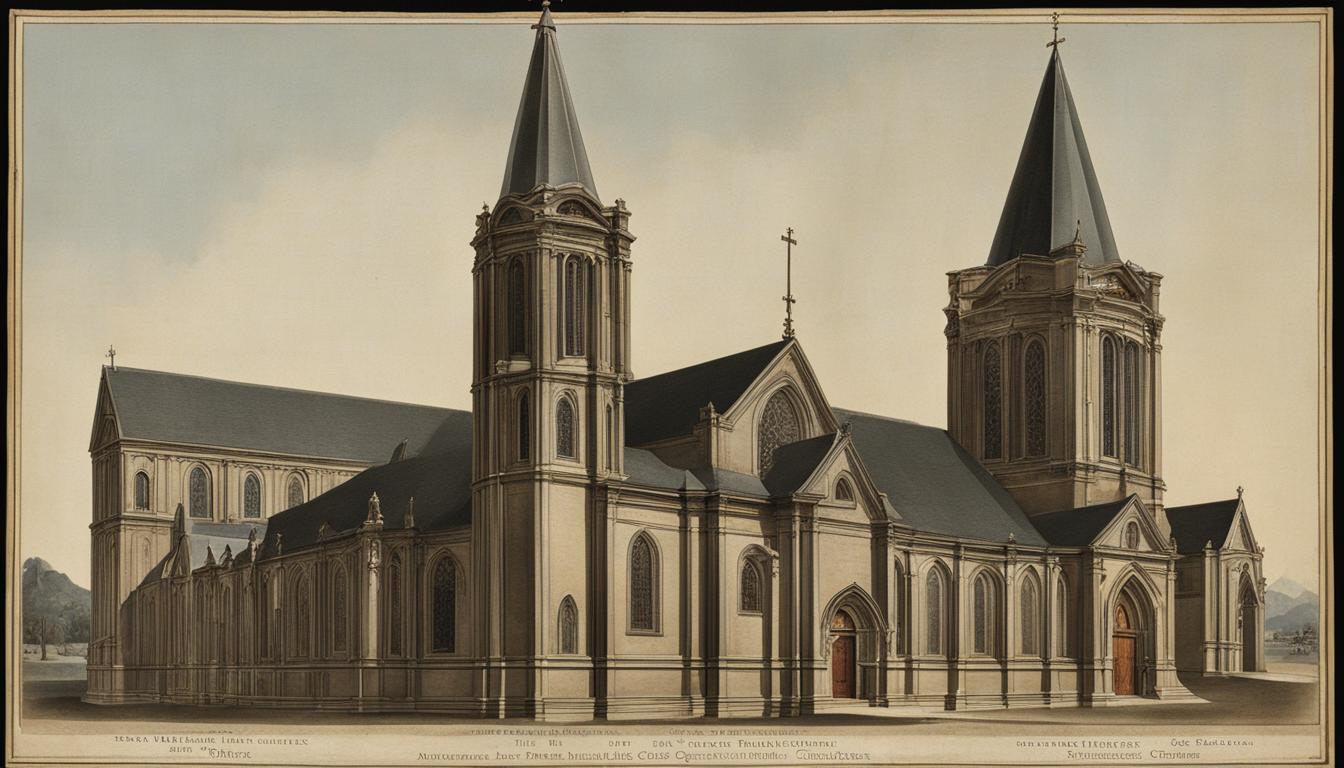The Mennonite Church has a rich and inspiring history that dates back to the 16th century, during the radical wing of the Protestant Reformation. This branch of the Christian church originated from the Anabaptist movement and was deeply influenced by the teachings of Menno Simons, a Dutch priest who played a significant role in its development.
Today, the Mennonite community boasts 2.2 million followers worldwide, with churches in various regions. Mennonites are known for their emphasis on peace, justice, simplicity, community, service, and mutual aid. Their faith is deeply rooted in the teachings of Jesus and the principles found in the Bible.
Key Takeaways:
- The Mennonite Church originated from the radical wing of the Protestant Reformation.
- Mennonites are known for their emphasis on peace, justice, simplicity, community, service, and mutual aid.
- Mennonites have a global presence with churches in various regions.
- Menno Simons, a Dutch priest, played a significant role in the development of the Mennonite faith.
- The Mennonite Church is deeply rooted in the teachings of Jesus and the principles found in the Bible.
Origins of the Mennonite Church
The Mennonite Church has its origins in the Anabaptist movement, which emerged during the Protestant Reformation in the 16th century. Anabaptists, including the Mennonites, believed in adult baptism and the significance of personal faith. The name “Mennonite” is derived from Menno Simons, a prominent figure who played a vital role in the development and spread of the Anabaptist faith.
“The words of Menno Simons continue to inspire and guide Mennonites today: ‘True evangelical faith cannot lie dormant. It clothes the naked, it feeds the hungry, it gives drink to the thirsty, it comforts the sorrowful, it shelters the destitute, it serves those that harm it, it binds up that which is wounded, it has become all things to all people.'”
– Menno Simons
During the early years, Mennonites faced severe persecution for their beliefs and commitment to nonviolence. Many were imprisoned, tortured, and even executed for their faith. As a result, Mennonites sought refuge in various parts of Europe, including the Netherlands, Switzerland, Germany, and Russia. These migrations played a significant role in shaping the diverse Mennonite communities we see today.
The principles and beliefs held by the early Anabaptists and Mennonites continue to guide the faith and practices of Mennonite communities worldwide. Central to their beliefs are the concepts of peace, justice, simplicity, community, and service. These core values remain at the heart of the Mennonite faith, shaping their interactions within the church and their engagement with the broader society.

Notable Anabaptists:
- Conrad Grebel
- Michael Sattler
- Felix Manz
- Dirk Philips
Beliefs and Doctrines of the Mennonites
Mennonites hold a range of beliefs and doctrines that are deeply rooted in their faith and shape their way of life. At the core of Mennonite beliefs is a commitment to peace, justice, and simplicity.
Mennonites place a strong emphasis on the close textual readings of the Scriptures. They believe in the authority of the Bible as the Word of God and strive to live according to its teachings. This emphasis on personal spiritual responsibility is a fundamental aspect of Mennonite faith.
A cornerstone of Mennonite beliefs is pacifism. Mennonites believe in the inherent value and sanctity of all human life, and thus reject violence and warfare. This commitment to nonviolence extends to various aspects of their lives, including their stance on military service. Many Mennonites choose alternative forms of service that contribute to peace and aid in times of conflict.
Furthermore, Mennonites embrace simplicity as a guiding principle. They value a lifestyle that is free from materialism and excessive consumption. By living simply, Mennonites seek to prioritize spiritual and communal values over material possessions.
“Our beliefs and doctrines are rooted in the teachings of Jesus Christ. We strive to live out his message of love, peace, and service in our everyday lives.”
The Anabaptist Influence
Mennonite beliefs and doctrines find their origins in the Anabaptist movement of the 16th century. The Anabaptists were a group of Christians who believed in adult baptism, the importance of personal faith, and the separation of church and state.
The Mennonites, named after Menno Simons, a prominent Anabaptist leader, adopted these core beliefs and further developed their own distinct theological perspectives.
Today, Mennonites continue to uphold and live out these beliefs and doctrines, drawing inspiration from their rich heritage and striving to be a peaceful and faithful presence in the world.

| Mennonite Beliefs | Mennonite Doctrines |
|---|---|
| Pacifism | Close textual readings of the Scriptures |
| Simplicity | Personal spiritual responsibility |
| Communal living and mutual aid | The sanctity of human life |
Sacraments and Rituals in the Mennonite Church
The Mennonite Church holds sacred the practice of sacraments and rituals that reflect their faith and beliefs. These sacraments and rituals serve as powerful expressions of their devotion and commitment to following Jesus Christ.
Baptism
One of the key sacraments in the Mennonite Church is baptism. Mennonites believe in the importance of believer’s baptism. This means that only adult believers who have personally chosen to follow Jesus Christ are baptized. Baptism is seen as a public declaration of one’s faith and a commitment to living a life of discipleship.
Communion
Communion, also known as the Lord’s Supper, is another significant sacrament in the Mennonite Church. During communion, Mennonites partake in a symbolic meal that represents the body and blood of Jesus Christ. This act of remembrance and worship is a deeply meaningful experience that strengthens the bond between believers and their Savior.
Other rituals may also be practiced within the Mennonite Church, such as footwashing and the holy kiss. These rituals serve as acts of humility, love, and unity among members of the community.
“Through the sacraments and rituals, Mennonites actively participate in their faith journey and reinforce their commitment to Christ and one another.”
The Mennonite Church values these sacraments and rituals as essential components of their worship and spiritual life. They provide a tangible expression of their beliefs and serve as reminders of God’s grace and love.

| Sacrament/Ritual | Meaning |
|---|---|
| Baptism | A public declaration of faith and commitment to following Jesus. |
| Communion | A symbolic meal representing the body and blood of Jesus. |
| Footwashing | An act of humility and service within the community. |
| Holy Kiss | A gesture of love, unity, and peace among believers. |
Leadership and Clergy in the Mennonite Church
The Mennonite Church holds a unique approach to leadership and clergy compared to some other Christian denominations. In the absence of a hierarchical clergy system, leadership roles within the Mennonite Church are often filled by individuals chosen by the community. This democratic principle ensures that the voices and perspectives of the congregation are valued and considered in the selection process.
Ordained ministers, deacons, and elders play key roles in guiding the Mennonite community. Mennonite pastors, in particular, are entrusted with the responsibility of leading worship services, providing spiritual guidance, and overseeing the life of the congregation. They are instrumental in shaping the faith and the character of the community through their knowledge, dedication, and commitment to the Mennonite principles.
The Mennonite pastors often receive comprehensive theological education to equip themselves for their pastoral roles. This education helps them develop a deep understanding of Mennonite beliefs, doctrines, and traditions, allowing them to offer guidance and support to the congregation effectively.
With their theological training and spiritual calling, Mennonite pastors provide pastoral care, administer sacraments, and lead congregational activities. They serve as mentors, counselors, and teachers within the faith community, nurturing the spiritual growth and well-being of the congregation as a whole.
By embodying the values of peace, justice, and community, Mennonite pastors exemplify the servant-leadership model that Mennonites hold dear. Through their commitment and dedication, they provide spiritual guidance, foster unity, and encourage the congregation to live out their faith in their daily lives.
Mennonite Leadership Roles:
| Leadership Role | Description |
|---|---|
| Ordained Ministers | Responsible for leading worship services, preaching sermons, and providing pastoral care to the congregation. |
| Deacons | Primarily focused on serving the physical and practical needs of the community, such as offering support to those in need or organizing community outreach programs. |
| Elders | Provide spiritual guidance and oversight to the congregation, serving as mentors and advisors. |
Mennonite Pastors’ Responsibilities:
- Leading worship services and preaching sermons.
- Providing spiritual guidance and support to individuals and families.
- Administering sacraments, such as baptism and communion.
- Leading and organizing congregational activities and events.
- Offering pastoral care, including counseling and mentoring.
- Overseeing the overall life and well-being of the congregation.
The Mennonite Church values the contributions and leadership of its pastors and recognizes their vital role in nurturing the faith and unity of the community. Through their service, Mennonite pastors inspire and guide the congregation, fostering a strong and vibrant Mennonite community.
Worship Practices in the Mennonite Church
Mennonite worship services embody simplicity and prioritize the active participation of the congregation. With a focus on fostering a sense of community, Mennonite worship typically consists of various elements, including hymn singing, prayers, Scripture readings, and sermons. This immersive experience allows Mennonites to engage deeply with their faith.
Mennonites have a rich tradition of a cappella singing, which holds a special place in their worship services. This form of singing, using only vocal harmonies without instrumental accompaniment, showcases their commitment to simplicity and worshiping with their voices alone. The practice of a cappella singing also reflects Mennonites’ desire to create an intimate and authentic connection with God and one another.
The hymns sung during Mennonite worship services are significant, often drawing from a long-standing tradition of hymnals unique to the Mennonite community. These hymns reflect the values, principles, and theological beliefs of the Mennonite Church. They are not simply musical expressions but a means to reinforce faith, provoke contemplation, and inspire devotion.
Worship styles can vary among different Mennonite congregations. While some Mennonite churches adhere to more traditional approaches with a cappella hymn singing, others may incorporate contemporary elements such as instrumental music, multimedia presentations, and praise bands. Despite these variations, the essence of Mennonite worship remains rooted in deep devotion, community engagement, and a rich musical heritage.

Mennonite Sacred Texts: Rooted in Biblical Authority and Teachings
The Mennonite Church holds the Bible as its primary sacred text, placing a strong emphasis on biblical authority and interpretation. For Mennonites, close textual readings and personal study of the Scriptures form the foundation of their faith and beliefs.
Mennonites believe that the Bible is not merely a historical document but a living and relevant guide for their daily lives. They view the Scriptures as the inspired word of God, seeking wisdom and guidance from its teachings.
Derived from biblical teachings and the influential works and writings of Anabaptist leaders such as Menno Simons, Mennonite teachings reflect a commitment to biblical principles and a desire to live out the teachings of Jesus Christ.
“The Bible is our sacred guidebook that shapes our worldview, guides our actions, and provides a roadmap for living a Christ-centered life.” – Mennonite belief
Mennonites engage in close textual analysis and scholarship to understand the historical context, literary genres, and cultural nuances of the Bible. They value rigorous study and thoughtful interpretation as they seek to apply biblical principles to contemporary life.
Through personal study, Mennonites strive to deepen their understanding of God’s teachings, finding inspiration and guidance for ethical decision-making, relationships, and social justice efforts.
By grounding their beliefs and practices in the sacred texts, Mennonites aim to lead lives that reflect their commitment to faith, peace, justice, and service to others.
The Bible as a Source of Inspiration and Guidance
- The Bible is viewed as the inspired word of God
- Mennonites engage in close textual readings and personal study
- Biblical teachings shape Mennonite beliefs and practices
- Anabaptist leaders’ works, such as Menno Simons, influence Mennonite teachings

Denominations and Sects within the Mennonite Church
The Mennonite Church is a diverse community with various denominations and sects, each with its own distinct practices and beliefs.
One well-known sect that originated from the Mennonite tradition is the Amish. In the late 1600s, the Amish separated from the Mennonites and developed their unique way of life. They are recognized for their plain dress, simple technology-free lifestyle, and strong emphasis on community and self-sufficiency.
Another significant denomination within the Mennonite Church is the Mennonite Brethren. This group emerged in the early 19th century and holds conservative beliefs, focusing on the authority of the Bible, personal conversion, and the need for a vibrant faith. They prioritize evangelism and missionary work.
The General Conference Mennonite Church is another prominent denomination. It values community, peace, and social justice. Mennonite Brethren share a commitment to biblical teachings and emphasize the importance of holistic discipleship.
The Conservative Mennonite Conference is a conservative branch within the Mennonite Church. They hold traditional beliefs and practices, emphasizing the separation from worldly influences and maintaining simplicity in daily life.
These are just a few examples of the denominations and sects within the Mennonite Church, each contributing to the vibrant and diverse tapestry of the Mennonite community.
Community and Outreach in the Mennonite Church
Mennonites are deeply rooted in their commitment to community and service to others. This emphasis on community extends not only to their fellow believers but also to those outside their faith. Through various outreach efforts and mission initiatives, Mennonites actively engage in making a positive difference in the world.
Both domestically and internationally, Mennonites are dedicated to serving those in need. They embody the values of compassion, love, and humility as they reach out to communities affected by poverty, disaster, or social injustice. Mennonite outreach programs focus on addressing immediate needs, providing sustainable solutions, and promoting long-term development.
Volunteer work is an integral part of the Mennonite community. Members eagerly contribute their time and skills to support various charitable organizations, whether locally or globally. From organizing food drives to building houses, Mennonites actively participate in initiatives that enhance the well-being and dignity of all people.
In addition to their tangible acts of service, Mennonites also prioritize the spiritual and emotional care of individuals. Mennonite communities offer a close-knit network of believers who provide support, encouragement, and a sense of belonging. They create inclusive spaces where everyone is welcomed, valued, and cared for.
Through their commitment to community and outreach, Mennonites strive to fulfill their calling to love and serve others as Jesus did. Their actions reflect their faith and embody the principles of peace, justice, and compassion.
Examples of Mennonite Outreach and Mission Initiatives:
- Disaster relief efforts: Providing immediate assistance, long-term recovery support, and rebuilding efforts in areas affected by natural disasters.
- International development projects: Collaborating with communities around the world to promote sustainable development, education, healthcare, and economic empowerment.
- Peacebuilding and conflict resolution: Engaging in initiatives that promote peace, reconciliation, and non-violent conflict resolution, both locally and globally.
- Prison ministries: Offering support, mentoring, and spiritual guidance to individuals within the criminal justice system.
- Medical missions: Sending medical professionals and volunteers to areas with limited access to healthcare, providing essential medical services and training.
Through these diverse outreach and mission endeavors, Mennonites demonstrate their commitment to living out their faith and making a positive impact in the world.
| Mennonite Community and Outreach Statistics | Domestic Outreach | International Missions |
|---|---|---|
| Number of Mennonite communities involved | 250 | 150 |
| Approximate number of individuals served annually | 500,000 | 1,000,000 |
| Average number of volunteer hours contributed | 2,000,000 | 3,500,000 |
| Number of charitable organizations supported | 300 | 200 |
Architectural and Artistic Features in Mennonite Churches
Mennonite churches showcase a diverse range of architectural styles, each with its own unique charm. While simplicity and functionality are common characteristics, these churches embrace both traditional and contemporary designs. From stately and grand structures to humble and modest buildings, Mennonite church architecture reflects the values and beliefs of the community.
Inspired by their commitment to peace, nature, and community, Mennonite art often graces the walls and interiors of these churches. Paintings, sculptures, and stained glass windows capture the essence of Mennonite faith through vibrant colors, intricate details, and thought-provoking imagery. These artistic expressions serve as visual reminders of the values that Mennonites hold dear.
Whether it’s the intricate woodwork adorning the pulpit or the beautiful hymnals embellished with calligraphy, artistic elements in Mennonite churches provide a serene and inspiring atmosphere for worship. The use of natural materials and earthy tones further enhances the connection to nature and simplicity that Mennonites value.
From wooden beams that reach toward the heavens to large windows that invite in natural light, Mennonite church buildings are designed to create a welcoming and sacred space. The architectural and artistic features within these churches not only reflect the aesthetics of the surrounding community but also serve as a visual representation of Mennonite beliefs and values.”
Contemporary Issues and Challenges in the Mennonite Church
The Mennonite Church, like any religious community, faces various contemporary issues and challenges. As the world evolves and changes, Mennonite communities strive to navigate these challenges while remaining grounded in their faith tradition.
Embracing Inclusivity
One of the challenges that Mennonite churches grapple with is the pursuit of inclusivity. As society becomes more diverse, Mennonite communities are examining how to welcome and affirm individuals of different backgrounds, cultures, and identities. This includes efforts to address issues of racial justice, gender equality, and LGBTQ+ inclusion, promoting an atmosphere of love and acceptance for all.
Navigating Generational Differences
Generational differences within Mennonite communities can also present challenges. Younger generations may have different perspectives on faith, worship styles, and social issues compared to older generations. Finding common ground and fostering intergenerational dialogue and understanding is crucial for maintaining unity and vitality within the church.
Engaging with Technology
In an increasingly digital world, Mennonite communities face the challenge of navigating modern technologies while upholding their values of simplicity and community. This includes finding the balance between utilizing technology for outreach, worship, and communication while avoiding excessive reliance or detrimental effects on personal relationships and spiritual practices.
Pursuing Social Justice
Social justice is a pressing issue for many Mennonite communities. They are actively engaged in addressing systemic inequities, advocating for peace, and working towards economic justice and environmental stewardship. The challenge lies in discerning how to effectively engage with these issues while remaining true to their core values and beliefs.
Despite these challenges, Mennonites continue to adapt and respond to the changing world. By embracing inclusivity, fostering intergenerational dialogue, navigating technology wisely, and actively pursuing social justice, Mennonite communities strive to make a positive impact and uphold their faith in contemporary society.
Conclusion
The Mennonite Church stands as a testament to the rich history and enduring legacy of the Anabaptist movement. From its humble beginnings amidst persecution in the 16th century, the Mennonite Church has grown to become a global community of believers united by their shared commitment to peace, service, community, and simplicity. Despite the challenges they face, Mennonites continue to uphold their faith and strive to live out their beliefs in the world.
The Mennonite Church’s emphasis on peace is deeply rooted in their belief that following Jesus means promoting justice and reconciliation. Their belief in the importance of service manifests in a multitude of ways, from domestic and international outreach efforts to volunteer work and support for charitable organizations. By practicing simplicity, Mennonites embrace a lifestyle that reflects their commitment to eschewing materialism and prioritizing spiritual and community wellbeing.
With their diverse beliefs, the Mennonite Church encompasses a range of denominations and sects, each with its own distinct practices and traditions. From the Amish, known for their rejection of modern technology, to the Mennonite Brethren and other denominations, the Mennonite community offers a mosaic of perspectives within their shared faith.
The Mennonite Church finds its spiritual guidance and inspiration primarily in the Bible. They believe in the value of close textual readings and personal study of the Scriptures, allowing biblical teachings to shape their beliefs and guide their lives. Mennonites also express their faith through worship practices that encourage congregational participation, uplifting hymns, and heartfelt prayers.
As the Mennonite Church faces contemporary societal challenges, such as questions of inclusivity and generational differences, they continue to adapt and respond while staying true to their core beliefs. Through it all, the Mennonite Church remains a beacon of hope, inspiring others with its unwavering commitment to faith, community, and a world guided by peace and justice.
FAQ
What is the history of the Mennonite Church?
The Mennonite Church originated from the radical wing of the Protestant Reformation in the 16th century. It traces its roots back to the Anabaptists, a movement within the Protestant Reformation. Mennonites faced persecution for their beliefs and sought refuge in different parts of Europe. Today, the Mennonite Church is a global community with a rich history.
What are the origins of the Mennonite Church?
The Mennonite Church originated from the Anabaptist movement within the Protestant Reformation. They believed in adult baptism and the importance of personal faith. Menno Simons, after whom the Mennonites are named, played a crucial role in the development of the faith. Today, Mennonites continue to uphold and live out their beliefs as a distinct Christian denomination.
What are the beliefs and doctrines of the Mennonites?
Mennonites hold a range of beliefs and doctrines, emphasizing peace, justice, and simplicity. They believe in the close textual readings of the Scriptures and personal spiritual responsibility as the basis of their faith. Pacifism is a cornerstone of Mennonite beliefs, leading many Mennonites to choose alternative service rather than military service. They also emphasize service to others as an important expression of their faith.
What sacraments and rituals are practiced in the Mennonite Church?
Baptism and communion are the key sacraments in the Mennonite Church. Mennonites believe in the importance of believer’s baptism, which is the baptism of adult believers who have made a personal decision to follow Jesus. Communion, also known as the Lord’s Supper, is a symbolic meal that represents the body and blood of Jesus. Other rituals, such as footwashing and the holy kiss, may also be practiced in some Mennonite communities.
What is the leadership structure in the Mennonite Church?
The Mennonite Church does not have a hierarchical clergy system like some other Christian denominations. Leadership roles are typically filled by ordained ministers, deacons, and elders who are chosen by the community. Mennonite pastors often have a theological education and are responsible for leading worship services, providing spiritual guidance, and overseeing the life of the congregation.
What are the worship practices in the Mennonite Church?
Mennonite worship services are characterized by simplicity and a focus on congregational participation. Worship often includes hymn singing, prayers, Scripture readings, and sermons. Mennonites value a cappella singing and have a rich tradition of hymnals and songs that reflect their faith and values. The style of worship may vary among different Mennonite congregations, with some embracing more contemporary elements.
What are the sacred texts of the Mennonite Church?
The primary sacred text of the Mennonite Church is the Bible. Mennonites place a strong emphasis on biblical authority and interpretation. They believe in the importance of close textual readings and personal study of the Scriptures. Mennonite teachings and beliefs are derived from biblical teachings and the teachings of Anabaptist leaders such as Menno Simons.
What are the different denominations and sects within the Mennonite Church?
The Mennonite Church is not a monolithic entity but consists of various denominations and sects. One well-known sect is the Amish, who separated from the Mennonites in the late 1600s and are known for their plain dress and rejection of modern technology. Other Mennonite denominations and sects include Mennonite Brethren, General Conference Mennonite Church, and Conservative Mennonite Conference. Each group may have its own distinct practices and beliefs.
How does the Mennonite Church prioritize community and outreach?
Mennonites place a strong emphasis on community and service to others. They are actively involved in outreach and missions, both domestically and internationally. Mennonites often engage in volunteer work and support various charitable organizations. Mennonite communities offer support and care for their members, creating a close-knit network of believers.
What are the architectural and artistic features in Mennonite churches?
Mennonite churches may vary in architectural style, but simplicity and functionality are common characteristics. Some Mennonite churches have traditional designs, while others embrace contemporary or innovative architectural approaches. Mennonite art often reflects their faith and values, with a focus on themes such as peace, nature, and community.
What are some contemporary issues and challenges faced by the Mennonite Church?
Like any religious community, the Mennonite Church faces various contemporary issues and challenges. These may include questions of inclusivity, generational differences, navigating modern technologies, and engaging with social justice issues. Mennonites continue to adapt and respond to the changing world while remaining grounded in their faith tradition.
What is the summary of the Mennonite Church?
The Mennonite Church has a rich history and diverse beliefs and practices. From its origins in the Anabaptist movement to its present-day global presence, the Mennonite Church continues to emphasize peace, service, community, and simplicity. Despite facing challenges, Mennonites remain committed to their faith and seek to live out their beliefs in the world.
















